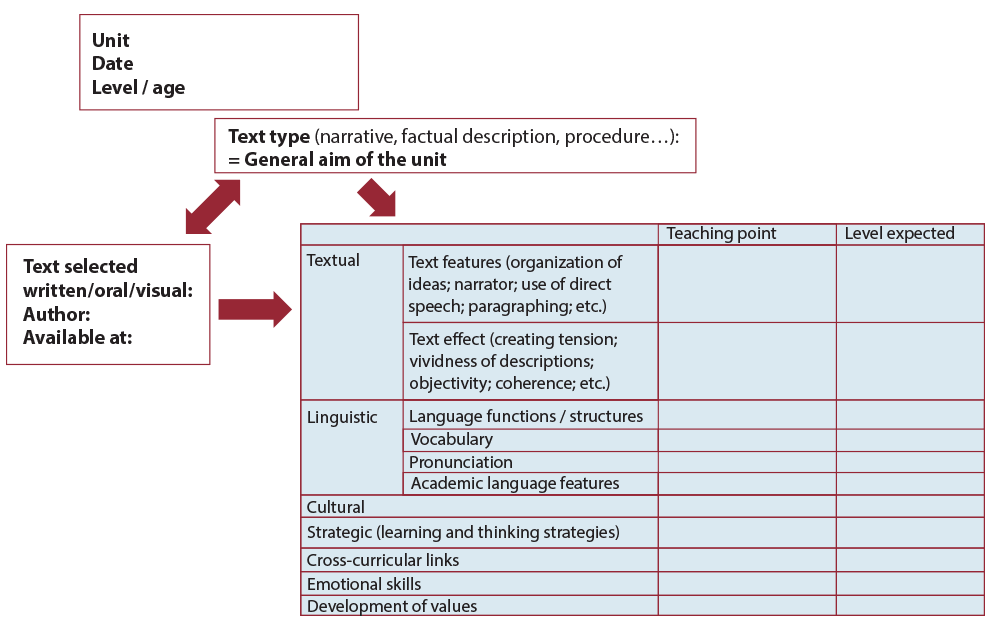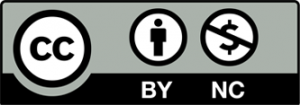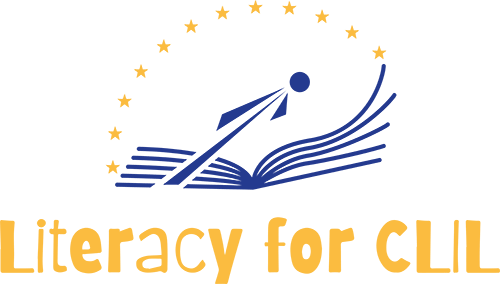Literacy Planning Grid
The Literacy Planning Grid consists of two parts – the overview page, which includes the main information about the unit, and the unit plan.
3.1 Grid Explanation
The Unit Overview records the topic, the age and grade of the students the unit was designed for. It also includes the information about the type of the text and its availability (Internet, print, etc.).
In the shaded table, the text features are listed as well as the strategy work, work on culture and cross-curricular links (among others) the text offers and that have been selected to be worked on. These are the teaching points the unit addresses. These teaching points, which are shaded, are later presented in the unit plan (also shaded). The last column in the table shows the level students are expected to work and perform at.
Unit overview

The Unit Plan
The unit plan developed for literacy teaching units is divided into the two phases of reception and production. This means that each unit takes a text, written, spoken or audio-visual, as its starting point. Once the text has been read, listened to or viewed, enjoyed and worked on, it serves as a model for students’ own production.
First Phase: Reception
In the first phase, work on the text is divided into a pre-reading / listening phase whose aim is to contextualize the text and create the necessary conditions for students to be able to understand it. Once students are ready for understanding the text, they read view or listen to it. Understanding here is not limited to the text’s literal meaning but may involve inference and interpretation, as well as relating the text to other known texts, responding to it, etc. Finally, this first phase concludes with work on the text itself, first from the perspective of its textual features (observing how the text is structured, what visual elements it includes, how it creates an effect, etc.) and secondly looking at its linguistic features (use of tenses, vocabulary, sentence complexity, use of sound effects, etc.), but always from the perspective of the effect this has on the reader / listener.
You may also listen to Irene explaining the main parts of the Literacy Grid in her own words.
RECEPTION
A. Reading
Phase I. Pre-reading / listening (create hook / open gateway to literacy / contextualize / aid understanding)

Phase II. Understanding and connecting (literal understanding, inferring meaning, interpreting, relating to own experience, responding)

B. Observing: recognizing text features (structure, narrator, vivid descriptions, factual information, objectivity of tone…)

C. Analysing: recognizing and practising language features (language functions, vocabulary, pronunciation)

Second Phase: Production
Once the students have worked on the text and are familiar with its characteristics, both textual and linguistic, they are ready to start their own production, first through guided work on specific aspects of the text they are going to create (structure, linking ideas, supporting explanations with images, building vocabulary, etc.), and then through free production of a written, audio-visual or oral text.
However, before we can work on a text in this way, we first need to be conscious of the teaching points or opportunities it offers. This is what goes into the first page of the planning grid, as a kind of overview of the unit. Here the text worked on and its genre are identified, and the teaching points it offers recorded in the shaded box. This includes the textual and linguistic features of the text to be worked on, but also identifies opportunities to work on other elements more related to learning strategies, cross-curricular links or emotional skills and values that are typically worked on in school. The teaching points, as recorded in this box, are found again in column two of the planning grid, thus making sure that what is identified as teaching points on the first page of the grid is actually dealt with when the unit is being developed.
Finally, although the process has been presented here in a linear fashion, working with a literacy approach does not have to be linear. In fact, at times it will be necessary or advisable to include more than one phase of “text-observation”, the teacher may decide to practise producing certain aspects of the text before working on other aspects, etc., thus making the planning more iterative than linear. This is represented by the arrows in the right-hand margin of the broken-down teaching sequence.
PRODUCTION
A. Guided production (ordering parts of text, creating vivid descriptions, make information factual, creating word banks, changing the register, finding and correcting mistakes, etc.)

B. Free production (planning, organizing, drafting, editing…)

3.2 Exemplary Grid
Below you will find an exemplary unit created by the teacher Irene Perez from the school Nuestra Señora Del Pilar in Madrid entitled, “Change the End of the Story”. The unit, “Writing narrative stories” is based on the readings from Roald Dahl’s “The Witches” and is designed for the 10-11 year old students (5th graders). In the reception part of the unit, students are given time to read, observe the narrative structure and analyze the language features which are used by the author to illustrate suspense and fear. In the production phase, students are guided extensively to produce some narrative characteristics similar to the original text, which later on might be used in their own writing. Students are acquainted with the specific language needed to express suspense and fear. In the free production students write their scary and unexpected ending of the story.
You may view the entire Literacy Grid created by Irene as a Pdf file below
Pdf (Witches) DOWNLOAD
3.3 Grid Template
You may download the Literacy Grid in a pdf or word format below.



Disclaimer
The European Commission’s support for the production of this publication does not constitute an endorsement of the contents, which reflect the views only of the authors, and the Commission cannot be held responsible for any use which may be made of the information contained therein.
Grant Agreement No. 2018-1-PL01-KA201-050920

